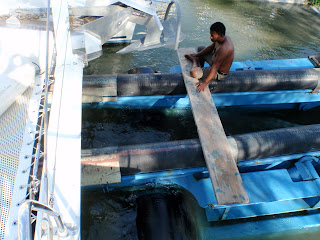Our cruising itinerary is mostly determined by where we can
have Tortuguita hauled out of the water and put on land for maintenance and
storage. In the past 10 years, we have
hauled in the Chesapeake, Grenada,
Bahamas, Honduras,
Mexico, Australia twice,
and now Malaysia. Prior to Australia,
we always lived aboard 'on the hard', even though many of the boatyards were
hot, buggy, dusty, dirty, and remote. We
just bit the bullet due to the economics.
In Australia,
the boatyard did not allow liveaboards on the 'hardstand' due to it's commercial
zoning status. However, it did allow
marina liveaboards. This forced us to do
something most cruisers don't like to do, spend money unnecessarily. It was expensive for an apartment in Oz but
we really did enjoy getting 'away from it all' at the end of the day. We really got to experience and learn the
area much more that way too. We also had
to rent a car, another expense, which did give us more freedom to explore.
 |
| The House |
So here we are, in Malaysia,
one of the best cost of living countries in the world. If we could afford Australia,
then Malaysia
should be a dream. Owing to the 100+
degree daytime temperatures and the need for a big floor space to set up the
sewing machine, we decided to share a house with Kiwi Mike from FINE
SPIRIT. The house belongs to the marina owner's mother
and is about 15 minutes away. The rent
is $450 US per month for this 5 bedroom furnished house. So our share, $225/month, is less than what 1
week cost us in Australia.
 |
| Our daily commute |
A small car can be rented from Hertz in the marina for
$350/week. Since this is so outrageously expensive, there is a cottage industry
of Malaysians renting private vehicles.
They can usually be rented for around $350/month.
Mike bought a beater car for $1500.
He plans to stay around for a few years so
buying a car to him was a no-brainer.
We
are not sure how long we'll be sticking around so it is difficult to make the
cost analysis but in the end we figured buying is better than renting.
 |
| The car parked in the 'driveway' of our house |
The hunt for a car began.
I had the best luck on the website
mudah.my
which is similar to
craigslist, or it's Australia
cousin
gumtree.
After trying
to contact about 10 sellers with no luck, I got a response from guy selling a
Volvo S40 in the town of Taiping, about 2 hours away.
Mike took
us up there.
We met at the DMV, which
they call JPJ.
The price was good,
$2500, the miles were low, 150K km, and it was in great shape.
I never owned a Volvo but am quite impressed
with the engineering detail in this vehicle.
It is right hand drive, of course, but we had plenty of right hand
driving experience in Australia.
Unlike the United
States, there is no sales tax on second hand
vehicles.
The road tax is $100/year.
Liability insurance is also $100/year. So
that afternoon, Booker and I were driving back to our air conditioned rental
house in our very own car.
Life's not so hard
on the hard, in Malaysia.












































